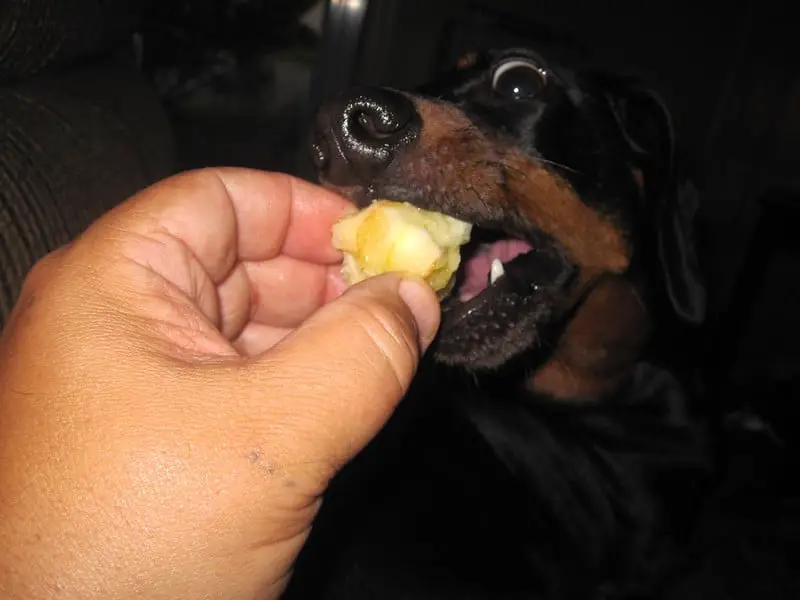
Many dogs love fruit, and fruits can make a tasty snack for dogs. But, what kind of restrictions do dogs face when it comes to fruit? How much fruit can a dog eat a day?
Well, in this article, we’re going to answer this question and more, so read on to find out more about the perks and pitfalls of giving your pooch a fruity snack or two:
So how Much Fruit Can a Dog Eat a Day? A dog should eat about 10% to 50% of the portion you would eat yourself, and should only have one or two portions of fruit in a day.
Which fruits do dogs love?
Blueberries, strawberries, and other berries are a perfect sweet treat for your dog! Not only do the vitamin C-rich blueberries help with a dog’s heart and brain function and, potentially, their blood sugar, blueberries are also a perfect portion size.
Just like with other treats, one or two of these manganese-laden blue spheres should be enough for most pooches at first, until you can gauge your dog’s reaction to blueberries.
You should also watch over smaller dogs closely, to ensure that they do not choke on the berries.
But with their cancer-fighting phytochemicals and antioxidant benefits, blueberries make a brilliant snack for your dog! Your pooch will love being fed one or two blueberries in exchange for doing their best tricks.
Did you know that coconut is considered to be fruit? You may have seen coconut oil being used in some dog treats, canine shampoos, and even some medicinal treatments.
This is with good reason – coconut flesh has loads of benefits for your pooch’s skin and coat.
However, it’s not just for hair. The lauric acid found in coconut flesh has tons of other benefits! This includes anti-fungal properties, anti-viral and anti-bacterial benefits, antioxidant, and anti-inflammatory properties.
Since inflammation is a major component in most health conditions, including allergies and arthritis, real coconut makes a brilliant treat for dogs. Sprinkle a few flakes of coconut into your dog’s food for a taste they will love!
Another tasty, seasonal snack option for pooches is pumpkin. A great all-rounder for its mineral, vitamin, fiber, and antioxidant content, pumpkin flesh can also help to treat mild diarrhea and constipation symptoms in dogs.
Scoop out one or two teaspoons of pumpkin and add it into your dog’s kibble for a little extra flavor or serve the delicious paste as a lickable treat. Larger dogs can consume two to three tablespoons.
Which fruits should I be careful about giving to my dog?
An apple a day keeps the doctor away, right? But this is not necessarily true in the case of dogs! While a dog can eat most parts of an apple, including the skin and stem, the seeds of an apple are something to be extremely vigilant about.
While apple seeds are harmless when ingested by a dog, the seeds later metabolize into cyanide in your dog’s body. Due to this, be sure to remove all seeds from any pieces of apple you intend to give to your pooch. Do the same with pears and watermelon slices.
But, if your dog sneaks up onto the table and eats a whole apple from the fruit bowl, don’t be too worried! The few seeds present in one apple are unlikely to lead to a fatal amount of cyanide being produced.
Do keep an eye on the dog, however, and contact your vet if you have any concerns.
Full of vitamin A and fiber, peaches are great for dogs. Sweet but not too acidic, a chunk or two of a peach is a perfect fruit for pooches. But, just like with apples, be sure to completely remove the peach amygdalin-laden pit before serving the juicy fruit to your dog.
While most small berries are fine for your dog, in moderation, feeding your pooch grapes is out of the question. Nobody knows quite why, but grapes are frequently fatal for dogs. If your pooch consumes even one grape or raisin, get in touch with your vet right away and monitor your dog closely.
As well as this, although berries are fine for dogs, did you know that raspberries naturally contain xylitol? So, even though your pooch would need to eat a truckload of the berries to get harmed, limit your dog’s portions of raspberries to just a few.
Lemon is another one to watch out for. While your dog actually can eat the fruit, lemons are simply too acidic for most dogs.
Lemons frequently lead to digestive problems, like diarrhea, in dogs. Anyway, your pooch isn’t likely to appreciate the fruit’s extremely bitter flavor!
And, of course, while always watching out for all seeds, carefully peel all fruits with thicker skins before giving them to your pooch and thoroughly wash fruits you do not peel, just as you would for yourself.
Which fruits can I safely give to my dog in moderation?
For most dogs, the size of an apple to them is basically what a watermelon is to humans. Therefore, only share a slice or two of your apple with your pooch (after checking it thoroughly for seeds, of course!).
For larger dogs, their portion could be increased to half of one of these crunchy, juicy treats.
Banana is a deliciously creamy treat that many dogs love, so it’s healthy for them too, right? Yes, bananas are perfectly safe for your pooch, as they are without any seeds, stems, or other unusual bits or pieces to worry about. But did you know that bananas contain high fiber and calories for such a soft food?
Because of this, you’ll need to watch for digestive issues when you first feed your pooch this fruit, as well as limiting how much banana you give to your dog.
Similar to an apple, around 10% of the fruit is a good amount to start with. You can increase this to 50% for a large dog.
It probably goes without saying, but don’t feed your dog any banana peel! While this waste part of the fruit isn’t toxic and is safe to eat, even a small amount of banana peel can quickly cause an obstruction inside your dog’s body if ingested.
Strawberries are another great option for your pooch. Full of antioxidants, fiber, and vitamin C, strawberries are a truly healthy treat. The berries even contain malic acid, which might help to whiten your pooch’s teeth!
The only thing you have to watch out for is the high sugar content, so keep to 1 or 2 berries.
In the same vein as lemons, citrus fruit, oranges have a similar level of acidity. But, due to the high vitamin C that the fruit contains, oranges do have some benefit for dogs.
So, if you like, start your dog on just one or two (seed-free) segments to see how they do.
How can I use fruits for my dog?
Fruits are sweet food that pooches see as being of high treat value. You may see your dog starting to perform all their best tricks as soon as they notice you peeling an apple or banana.
So, it’s no surprise then that many trainers pick certain fruits to cut up and use when they train dogs.
One example is blueberries. Just like with your usual treats, feed your pooch a berry when they perform a trick well. Or you could even hide a berry underneath one of three cups and have your dog use their nose to sniff the tasty snack out. Finely chopped banana or apple cubes also work well for this purpose too!
If you come across blackberries while out for a ramble, toss a couple your dog’s way, as long as the berries are far enough away from the road and other sources of pollution.
Another great way to use softer fruits, like coconut, pumpkin, or banana, is to mash them up and let your pooch lick the healthy paste. You could stuff a Kong toy with this delicious soft food (such toys are also great plaque busters into the bargain!) or smear it over a licking mat.
The next time you need your dog to settle down for bathing or grooming or to give them something to do when you go out, mash their favorite soft fruit up to keep them occupied for a time!
When the weather is hot, fruits like blueberries and bananas can be frozen. Then, you can give your pooch these sweet treats as a healthy way to help them cool down.
You can freeze berries in an ice cube tray for your dog to lick to the center, or just freeze a paste, like banana or coconut in a licking toy, for a longer-lasting cooling treat.
Watermelon cubes, without seeds, are a juicy treat for a sweltering summer’s day for you pooches too.
So, how much fruit can a dog eat in a day?
In short, a dog should eat about 10% to 50% of the portion you would eat yourself, and should only have one or two portions of fruit in a day.


